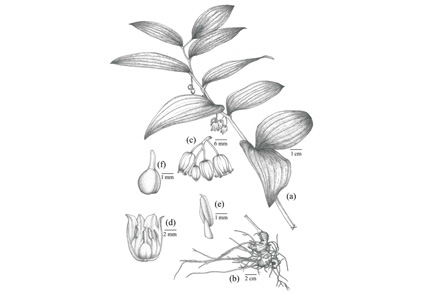Abstract
Polygonatum binatifolium, from Guizhou, China, is newly described and illustrated. The new species is morphologically most similar to P. cyrtonema in sharing an erect stem, pendulous flowers, glabrous peduncles and pedicels, campanulate, yellowish green perianths, and glabrous, included stamens, but differs by its shorter stems (20–50 cm vs. 50–100 cm), fewer leaves (5–9 vs. 10–15) of which the lowermost two being opposite, fewer flowers (up to 5 vs. up to 14), shorter peduncles (2–5 mm vs. 1–6 cm), shorter filaments (ca. 1.0 mm vs. 3–4 mm) and anthers (1.6–1.9 mm vs. 3.5–4.0 mm), smaller ovary (1.8–2.2 mm vs. 3.0–6.0 mm) and shorter styles (1.5–2.0 mm vs. 1.2–1.5 cm), and smaller berries (5.5–6.5 mm vs. 6–12 mm) and seeds (2.4–3.0 × 2.0–2.4 mm vs. 3.8–5.6 × 2.8–3.6 mm). The species can be categorized as Critically Endangered (CR).
References
APG IV (2016) An update of the angiosperm phylogeny group classification for the orders and families of flowering plants: APG IV. Botanical Journal of the Linnean Society 181 (1): 1–20. https://doi.org/10.1111/boj.12385
Cai, X.Z., Hu, G.W., Kamande, E.M., Ngumbau, V.M. & Wei, N. (2015) Polygonatum campanulatum (Asparagaceae), a new species from Yunnan, China. Phytotaxa 236 (1): 94–96. https://doi.org/10.11646/phytotaxa.236.1.10
Chase, M.W., De Bruijn, A.Y., Cox, A.V., Reeves, G., Rudall, P.J., Johnson, M.A.T. & Eguiarte, L.E. (2000) Phylogenetics of Asphodelaceae (Asparagales): an analysis of plastid rbcL and trnL-F DNA sequences. Annals of Botany 86: 935–951. https://doi.org/10.1006/anbo.2000.1262
Chen, H.Y., Huang, Y., Zhou, X.X. & Yi, S.R. (2021) Polygonatum caulialatum, a new species of medicinal plant of Polygonatum (Asparagaceae) from Sichuan, China. Phytotaxa 513 (1): 55–61. https://doi.org/10.11646/phytotaxa.513.1.3
Chen, S.C. & Tamura, M.N. (2000) Polygonatum Miller. In: Wu, Z.Y. & Raven, P.H. (Eds.) Flora of China, vol. 24, Science Press, Beijing, and Missouri Botanical Garden Press, St. Louis, pp. 223–232.
Dahlgren, R.M.T., Clifford, H.T. & Yeo, P.F. (1985) The families of the monocotyledons. Structure, evolution and taxonomy. Springer-Verlag, Berlin, pp. 520. https://doi.org/10.1007/978-3-642-61663-1
Deng, X.Y., Zhou, S.D. & He, X.J. (2007) Pollen morphology of 13 Chinese species of Polygonatum and its systematic significations. Journal of Wuhan Botanical Research 25 (1): 35–42.
Engler, A. (1888) Liliaceae. In: Engler, A. & Prantl, K. Die natürlichen Pflanzenfamilien. W. Engelmann, Leipzig, pp. 10–22.
Floden, A.J. (2014) A new combination in Polygonatum (Asparagaceae) and the reinstatement of P. mengtzense. Annales Botanici Fennici 51 (1–2): 106–116. https://doi.org/10.5735/085.051.0115
Hance, H.F. (1883) Disporopsis, Genus novum Liliacearum. Journal of Botany, British and Foreign 21: 278.
IUCN Standards and Petitions Committee. (2019) Guidelines for Using the IUCN Red List Categories and Criteria (Version 14). Prepared by the Standards and Petitions Committee, pp. 9–16. [http://www.iucnredlist.org/documents/RedListGuidelines.pdf]
Jang, C.G. & Pfosser, M. (2002) Phylogenetics of Ruscaceae sensu lato based on plastid rbcL and trnL-F DNA sequences. Stapfia 80: 333–348.
Judd, W.S. (2003) The genera of Ruscaceae in the southeastern United States. Harvard Papers in Botany 7: 93–149.
Liu, H.H., Ma, Y.S., Wang, B.Z., Jie, H.D., Xiang, S.J., Yang, J.N. & Jie, Y.C. (2021) Morphological and molecular characters on a new species of Polygonatum from Hunan, China. Crop research 35 (1): 88–94.
Long, J.F., Zhou, B.H., Wei, G.L. & Wang, X. (2020) Investigation and study on the resources of the geniune Polygonatum Mill. in Qiandongnan area of Guizhou Province. Asia-Pacific Traditional Medicine 16 (8): 11–14. https://doi.org/10.11954/ytctyy.202008004
Meng, Y., Nie, Z.L., Deng, T., Wen, J. & Yang, Y.P. (2014) Phylogenetics and evolution of phyllotaxy in the Solomon’s seal genus Polygonatum (Asparagaceae: Polygonateae). Botanical Journal of the Linnean Society 176: 435–451. https://doi.org/10.1111/boj.12218
Miller, P. (1754) The Gardeners Dictionary. Abridged. Vol. ? ed. 4. C Rivington, London, 559 pp.
Tamura, M.N., Ogisu, M. & Xu, J.M. (1997) Heteropolygonatum, a new genus of the tribe Polygonateae (Convallariaceae) from West China. Kew Bulletin 52 (4): 949–956. https://doi.org/10.2307/4117821
Tamura, M.N., Fuse, S., Li, H., Yang, Y.P., Meng, Y. & Ikeda, H. (2014) Polygonatum dolichocarpum (Asparagaceae), a new species from Yunnan, China. Phytotaxa, 65 (3): 157–159. https://doi.org/10.18942/apg.KJ00009868526
Tang, Y.C. (1978) Polygonatae. In: Wang, F.T. & Tang, T. (Eds.) Flora Reipublicae Popularis Sinicae, vol. 15: 26–87. Science Press, Beijing.
Utech, F.H. (2002) Polygonatum. In: Flora of North America Editorial Committee (Ed.) Flora of North America, vol. 26, Oxford University Press, Oxford, pp. 210–212.
Wan, M.X., Xu, W.F. & He, S.Z., (2015) Study on medicinal germplasm resources of Ophiopopon and Polygonatum in Guizhou. Seed3 4 (7): 59–62. https://doi.org/10.16590/J.cnki.1001-4705.2015.07.059
Wang, S.Q., Hong, D.Q. & Gao, C.X., (2009) Resource investigation and variety identification of Polygonatum Mill. from Guizhou. China Modern Medicine 6 (8): 50–51. https://doi.org/10.3969/j.issn.1674-4721.2009.08.029
Wu, Z.L. & Yang, Y.C. (2005) A new species of Polygonatum Mill. from Qinghai, China. Acta Botanica Boreali-Occidentalia Sinica 25 (10): 2088–2089. https://doi.org/10.3321/j.issn:1000-4025.2005.10.027
Yamashita, J. & Tamura, M.N. (2000) Molecular phylogeny of the Convallariaceae (Asparagales). In: Wilson, K.L. & Morrison, D.A. (Eds.) Monocots: systematics and evolution. CSIRO Publishing, Melbourne, pp. 387–400.
Yang, H., Baohuan, W.U., Chen, Z., Wang, P. & Cui, D. (2020) Polygonatum daminense (Asparagaceae), a new species from China based on morphological and molecular evidence. Phytotaxa 449 (3): 287–294. https://doi.org/10.11646/phytotaxa.449.3.7
Zhao, L.H. & He, X.J. (2014) Polygonatum gongshanense (Asparagaceae), a new species from Gongshan, Yunnan, China. Annales Botanici Fennici 51 (5): 333–336. https://doi.org/10.5735/085.051.0511
Zhao, L.H., Zhou, S.D. & He, X.J. (2018) A phylogenetic study of Chinese Polygonatum (Polygonateae, Asparagaceae). Nordic Journal of Botany 37 (2): 1–10. https://doi.org/10.1111/njb.02019
Zhu, Z.Y. (1992) A new species of Polygonatum from Emeishan. Bulletin of Botanical Research 12 (3): 267–269.
Zuo, J.H., Sun, A.Q. & Xiang, H. (2003) Studies on plant taxonomy and medical-value of Polygonatum Mill. in Area of Shuicheng. Journal of Liupanshui teachers College 15 (4): 1–4. https://doi.org/10.3969/j.issn.1671-055X.2003.04.001


